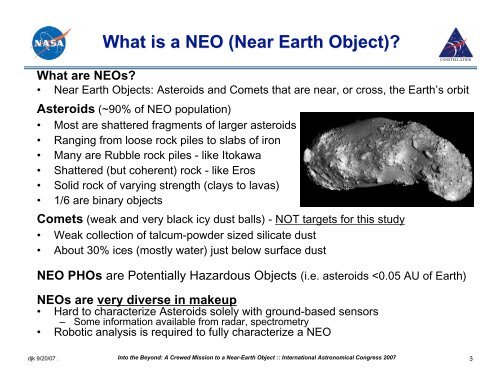Into the Beyond: A Crewed Mission to a Near-Earth Object - NASA
Into the Beyond: A Crewed Mission to a Near-Earth Object - NASA
Into the Beyond: A Crewed Mission to a Near-Earth Object - NASA
You also want an ePaper? Increase the reach of your titles
YUMPU automatically turns print PDFs into web optimized ePapers that Google loves.
djk 9/20/07 .<br />
What is a NEO (<strong>Near</strong> <strong>Earth</strong> <strong>Object</strong>)?<br />
<strong>In<strong>to</strong></strong> <strong>the</strong> <strong>Beyond</strong>: A <strong>Crewed</strong> <strong>Mission</strong> <strong>to</strong> a <strong>Near</strong>-<strong>Earth</strong> <strong>Object</strong> :: International Astronomical Congress 2007<br />
CONSTELLATION<br />
What are NEOs?<br />
• <strong>Near</strong> <strong>Earth</strong> <strong>Object</strong>s: Asteroids and Comets that are near, or cross, <strong>the</strong> <strong>Earth</strong>’s orbit<br />
Asteroids (~90% of NEO population)<br />
• Most are shattered fragments of larger asteroids<br />
• Ranging from loose rock piles <strong>to</strong> slabs of iron<br />
• Many are Rubble rock piles - like I<strong>to</strong>kawa<br />
• Shattered (but coherent) rock - like Eros<br />
• Solid rock of varying strength (clays <strong>to</strong> lavas)<br />
• 1/6 are binary objects<br />
Comets (weak and very black icy dust balls) - NOT targets for this study<br />
• Weak collection of talcum-powder sized silicate dust<br />
• About 30% ices (mostly water) just below surface dust<br />
NEO PHOs are Potentially Hazardous <strong>Object</strong>s (i.e. asteroids

















